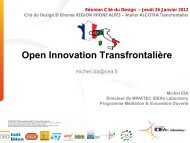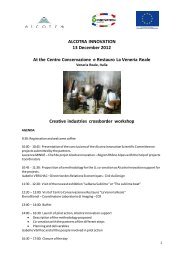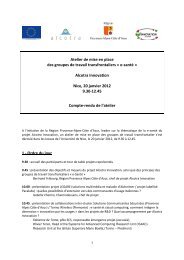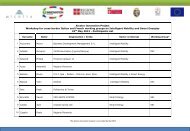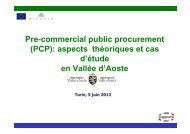Best practices Database for Living Labs - ALCOTRA - Innovation
Best practices Database for Living Labs - ALCOTRA - Innovation
Best practices Database for Living Labs - ALCOTRA - Innovation
Create successful ePaper yourself
Turn your PDF publications into a flip-book with our unique Google optimized e-Paper software.
Figure 10: <strong>Living</strong> <strong>Labs</strong> as Functional Regions (from: [3])<br />
3.5.2 Operating conditions<br />
<strong>Living</strong> <strong>Labs</strong> also differentiate because of the playground in which innovation is grown. ENoLL’s definition<br />
prescribes ‘real-life’ environments, which encourage carrying out the innovation process in an uncontrolled<br />
context that is fully consistent with the product’s or service’s usage conditions. In particular, Følstad’s<br />
review ([28], p. 116) proposes an attenuated definition whereby innovation takes place in “(semi)realistic<br />
contexts”, thus considering to engage users either in partly controlled environments or in what is often<br />
described as the uncontrolled “real-life”.<br />
‘Users’ here generally means ‘end users’, or those specific persons adopting and being impacted by the<br />
innovation considered. In other words, the term relates to citizens, consumers and possibly employees, if<br />
that innovation assumes an organizational meaning. A particularly important category of end users is<br />
represented by the “lead users”, described [in 29] as a particular group of people “on the leading edge of<br />
the market with respect to important market trends”. The two defining characters of lead-users are that (a)<br />
they are ahead with respect to important market trends, typically early adopters, and (b) they expect to<br />
gain relatively high benefits from a given solution [30].<br />
More recently, the Web 2.0 explosion has demonstrated the positive impact of involving user communities<br />
in mass collaboration projects (e.g. Wikipedia, crowdsourcing, etc.) that collectively create new contents<br />
and applications. Because of heterogeneity of users’ requirements and the growing demand <strong>for</strong> solutions<br />
that are more precisely meeting individual needs, the innovation driven by users provides a very necessary<br />
complement to manufacturer innovation. In practice, however, it is often very difficult to shift product<br />
development activities from manufacturers to lead users: if it is not possible to find representative users <strong>for</strong><br />
all user groups, a broad variety of users is needed to assess all relevant user needs.<br />
This condition that user involvement activities should take place in real-world contexts is a main difference<br />
between the <strong>Living</strong> Lab approach and traditional user involvement methods. This means, <strong>for</strong> example, that<br />
potential users are involved all day round. Hence, the aim here is to create as authentic a usage situation as<br />
possible, whereas in traditional practice users can be asked to use a system or device in a so-called field<br />
study, then in a not fully authentic context.<br />
The rationale <strong>for</strong> such realism having instrumental value in <strong>Living</strong> <strong>Labs</strong> is that innovations should ultimately<br />
take place in the “real world”. For example, if a user tests a mobile service, s/he can gain understanding of<br />
how it functions and fits into her/his usage context at all times and in diverse ordinary situations: at the end<br />
Page 21 of 78<br />
The project is co-funded by the ERDF



